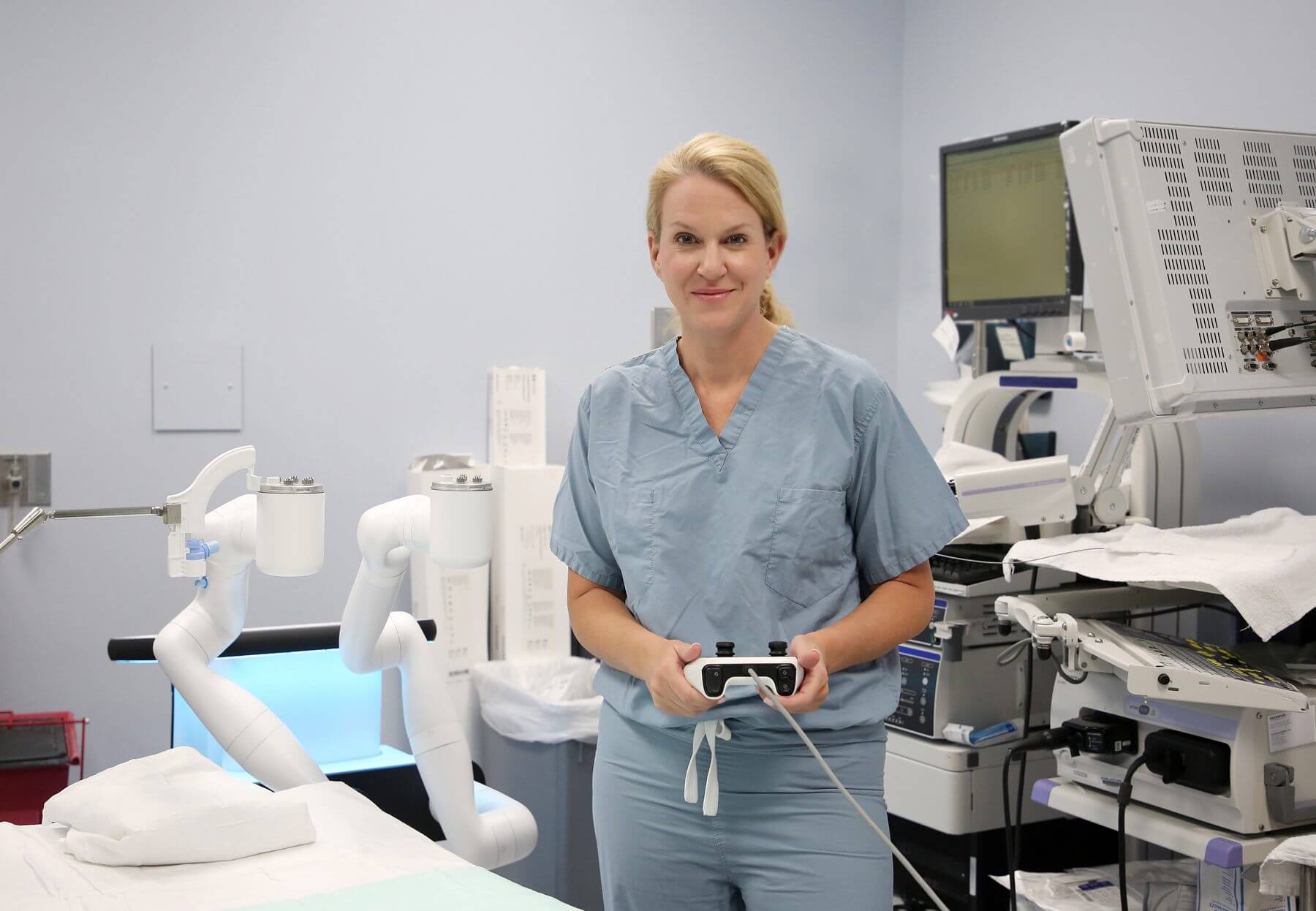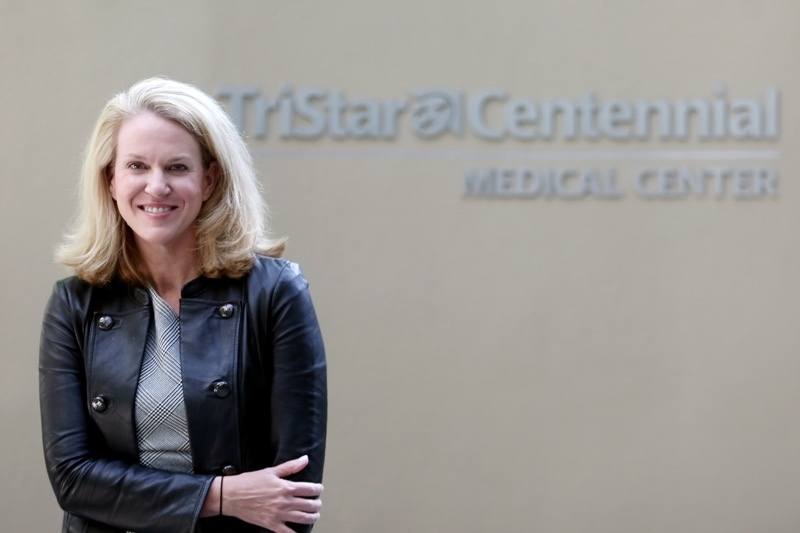Dr. Susan Garwood was a young girl when her grandfather was diagnosed with cancer. “It was an odd way to fall in love with medicine,” the TriStar Centennial interventional pulmonologist admits, but the experience led her to a career in medicine, but moreover, to pursue a passion for treating patients with empathy, kindness, honesty and transparency — all things she found were lacking during her grandfather’s treatment. In her work, Dr. Garwood is often the first touchpoint for patients in their cancer journey. “I knew I had a passion for oncology, and I felt like I could be most impactful at the beginning of a cancer diagnosis because I think that really can shape a person’s outlook,” she shares.
With internal medicine training at Vanderbilt University and a pulmonology and critical care fellowship at Medical University of South Carolina, Dr. Garwood is armed with a solid education and more than a decade of experience. Today, she performs procedures to find and diagnose lung cancer at its earliest stage, and she recently became the first female in the United States to use Auris Health’s MonarchTM Platform, just one example of how she is helping to make major advancements in her field.
Learn more about these technological advances, the latest statistics in lung cancer diagnoses in women, and find out why Dr. Garwood says getting scanned should be a priority. Meet our newest FACE of TriStar!

What are some changes being made in the field of lung cancer in terms of detection and treatment?
We are moving so quickly in the space — that is the beauty of being here. When I went through my training, I trained with traditional bronchoscopy and ultrasound guidance focusing on lymph nodes and central tumors. It was very cutting edge at the time, but the thought of navigational bronchoscopy or using GPS to drive around in someone’s lungs was not anything that I was exposed to when I went through fellowship.
I began to wonder, if we could find small nodules on lung imaging, how could we navigate to them? Most recently, we became the first system in Tennessee to use Monarch, which is a robotic navigational bronchoscopy system that uses a robotic controller to navigate through the patient’s lungs using GPS guidance, just like your car.
Before, when I put a scope in, I could really only see in the center of the lung. Now, I can drive even to the edges of the lungs with full visualization; I can look cancer in the face as I biopsy. With this system, we have found nodules that are smaller than a pea, and if you are able to find lung cancer when its smaller than a centimeter, the survival rate is more than 90%. This is a huge difference just in my lifetime, and there are many years to come where technology will continue to advance.


TriStar Centennial was among the first hospitals to utilize this technology. Why is it important to work in a hospital dedicated to growth and innovation?
That is why I am here. TriStar Centennial bought into innovation, but more than anything, they bought into me as a physician. They have provided support and have invested in me, which has allowed me to invest in my patients.
We just got our 2018 staging data that tells you how advanced lung cancers are when they are detected. The goal is to find as many people in the early stages. Around the country, about 25% of people are found in Stage 1 and 2. At Centennial, 47% of people are found in Stage 1 and 2. To have the administration see the vision and help operationalize that is tremendous.
What other advancements are taking place?
We have done things from the identification of nodules using computer programs to creating platforms for screening and detection. The big push here is to screen as many patients as we can. Within the country, 8 million people qualify for lung screening, and to-date, less than 3% of those people have been screened. A trial in 2011 published in the New England Journal of Medicine shows that if you get a lung screen, 20% of the time, it can save your life. It takes 1,000 mammograms to save a life; it takes 500 colonoscopies to save a life; it only takes 320 CT lung screens to save a life.

When it comes to lung health, where do we lack awareness?
A lot of the patients have smoked or are current smokers. They think that if they get it, they deserve it. We try to change that mentality. If you have lungs, you can get lung cancer. Obviously, we want patients to stop smoking, but know that if you have smoked in the past, a CT lung screening can save your life.
Lung cancer in nonsmoking women is rising faster than any other lung cancer group. We don’t know if that is genetics or environmental or why that is. The biggest thing is not to ignore symptoms, specifically if you are a non-smoking female. A persistent cough, coughing up blood and atypical chest discomfort all warrant scan. Often, we have to self-advocate to get the imaging we need. It’s also important to remember if you have a nodule, don’t ignore it. Early-stage lung cancer is often asymptomatic. It truly is a silent killer.
Smoking cessation remains our biggest opportunity to save lives from lung cancer. Cigarettes cause cancer, plain and simple. While e-cigarettes are regulated in Europe, they aren’t here. There has been an explosion of e-cigarette and vaping use in teens throughout the U.S. Not only can this be considered a gateway for teens to become smokers, but the unregulated nature of these products is also gaining increasing press for the dangers associated with them.

Where can we find you when you aren’t working?
I am “momming” so hard. My kids call me MTSM (Multitasking Super Mommy). I have a 10-year-old and a 13-year-old, and they are extraordinarily active in sports. A lot of my activities revolve around that, and I love it. When I have a moment to myself, though, I am on the trails at Percy Warner; I love to hike the 5.8-mile loop. You can get lost in nature and have a moment to decompress.
Learn more about Dr. Garwood and the pulmonary health services available at TriStar Centennial at TriStarCentennial.com.
This article is sponsored by TriStar Health. All photography by Leila Grossman.



















